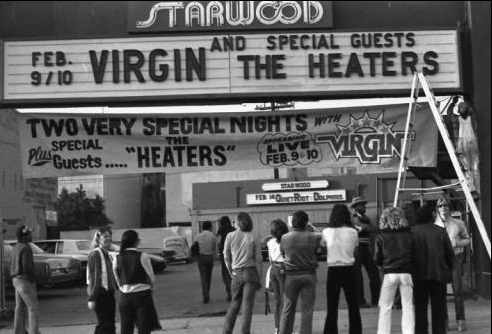
This is another in a series of articles about West Hollywood’s stretch of Route 66 that runs along Santa Monica Boulevard. The former Starwood Club is one of the highway’s rock and roll landmarks, as designated by Route 66 News.
Mötley Crüe played its first-ever concert together as a band on April 24, 1981, at the former Starwood Club on Santa Monica Boulevard at Crescent Heights. Bass guitarist Nikki Sixx arranged the debut gig through his day job cleaning up the club after previous nights’ concerts. He begged until his boss relented and let Sixx’s new group play two sets opening for venerable hard rockers Y&T.
The Crüe, of course, emerged as one of the most successful local acts ever to come out of the Sunset Strip music scene, having started modestly at the Starwood. Credit (or blame) for the several decades of world class debauchery that followed is another story altogether, to say nothing of hair big enough to have its own atmosphere.
A few months after Mötley Crüe’s Starwood show, the club was no longer, shut down permanently by Los Angeles County authorities. Officially, its business license was revoked for underage drinking violations and neighborhood complaints about illegal drug use, violence and vandalism. In sociological terms, the club committed punk rock with intent to perpetrate glam metal.
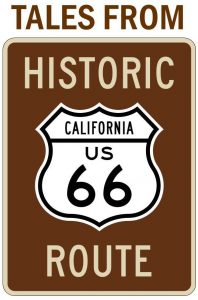 That was 35 years ago. The closure ended a notable eight-year run that began when the Starwood opened in 1973. The Los Angeles Times called it “a music industry showcase spot,” adding, “The heyday for L.A. clubs started when the Whisky and the Starwood were the only major rooms.”
That was 35 years ago. The closure ended a notable eight-year run that began when the Starwood opened in 1973. The Los Angeles Times called it “a music industry showcase spot,” adding, “The heyday for L.A. clubs started when the Whisky and the Starwood were the only major rooms.”
Its legacy lies in helping revitalize a club scene that was struggling during the 1970s following the raucous and revolutionary Sixties. It was one of the first to book important local punk and new wave bands as well as those in the fledgling metal scene – especially if they didn’t have record company deals.
The Starwood was a stomping grounds and career launch point for Van Halen, X, the Germs, Fear, the Dickies, Circle Jerks, the Knack, W.A.S.P. (known as Circus Circus at the time), the Motels, Quiet Riot, the Knack, Dokken, the Runaways and the Go-Go’s.
Gene Simmons is one of two record company types who claimed to have discovered Van Halen at the Starwood after seeing them on stage Nov. 2, 1976. What’s known for sure is that the former Kiss bass guitarist was so impressed he flew the whole group to New York within days to produce a session at his own expense.
Acts from outside California that played the Starwood regularly included The Damned, Devo, the Jam, Cheap Trick, the Ramones, the Dead Boys, the Stranglers, AC/DC, Slade, Rush, UFO and the Fleshtones.
“It was hard for a local band to get into the Whisky a Go Go, which featured mostly touring acts, as well as Gazzarri’s, which showcased bands doing covers (performing previously recorded songs),” writes author David Konow in his book “Bang Your Head – the Rise and Fall of Heavy Metal.” “For many young groups, the Starwood was the only game in town.”
“Fans from all over Southern California started to gravitate to the Starwood as it became ground zero for L.A.’s burgeoning rock scene,” Konow notes. In addition to the main stage where rock bands played, there was a disco and a smaller concert hall for folk or any other genre.
Listeners of KROQ-FM radio station were quite familiar with the Starwood thanks to DJ Rodney Bingheimer (“Rodney on the ROQ”) spinning records twice a week from the disco. Bingheimer’s Sunday evening indie-punk-pop show carried live interviews with bands playing the Starwood.
“By 1977, the Starwood had become a local rock institution. More and more recording artists wanted to play there,” according to the website “Rock and Roll Roadmaps.” “Every Sunday, however, the club gave local rock groups a chance to play. Rock and roll shifted back to smaller clubs from large arenas and outdoor stadiums.”
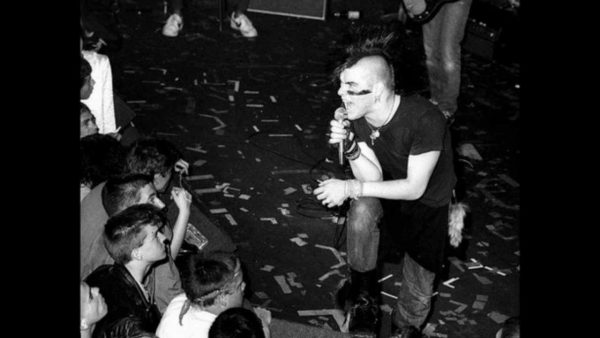
White Punks on Dope – Or White Dopes on Punk?
Southern California had its own version of Sid Vicious – Darby Crash, lead singer and songwriter for L.A.’s hottest punk band in the late 1970s, the Germs. A junkie and a fan of Charles Manson, the self-destructive Crash couldn’t decide if he wanted to be a music business legend or a cult leader.
The Starwood is where the Germs played their last concert together with Crash on Dec. 3, 1980. He committed suicide four nights later using heroin – just like Sid Vicious. He bought the heroin with his cut of the proceeds from that final gig.
The day after Crash’s suicide, John Lennon was shot and killed. News about Crash’s demise was pushed to the back pages, if noted at all, in the avalanche of media coverage about the beloved and greatly admired former Beatle. Crash’s plan to become a legend got off to a bad start. After a three-year career, he left only one extended play record (for promotional use) and a single album for the world to worship.
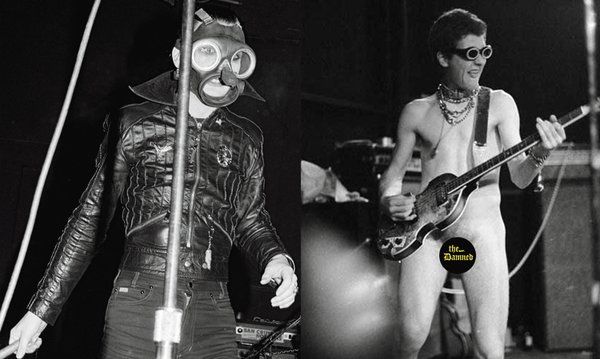
The Camelot of Quaaludes
The Starwood’s hands were far from clean when it came to illegal drugs. Its owner was none other than Eddie Nash, a dangerous drug kingpin and powerful underworld figure in the 1970s and 80s. Police say he was the mastermind behind the “Wonderland” murders of four people in Laurel Canyon who were bludgeoned to death in 1981 for allegedly stealing drugs from Nash.
When police raided the Starwood in connection with the murders, they found a box with 4,000 Quaaludes marked “For distribution at the box office,” according to Kanow’s book. “The Starwood was one of the easiest places in Southern California to score Quaaludes, which were all the rage throughout the 1970s,” according to the book “Bang Your Head.” “A local doctor supplied the Starwood regulars, and his office (next door) became known as Camp Quaalude. Every Saturday morning the line in front of his office would stretch for blocks. The cops would drive by and think the kids were lining up for concert tickets,” the book claims.
Don Dokken, founder of hard rockers “Dokken,” talked about illegal drugs’ prevalence throughout the Starwood in an oral history interview with Salon.com. “There were piles (of cocaine) on the tables upstairs at the Starwood. Coke and Quaaludes; you just snapped your fingers and it happened – it was free,” he told the web publication.
The Starwood, at 8151 Santa Monica Blvd., formerly was P.J.’s nightclub in the 1960s. A fashionable jazz and pop music venue, P.J.’s attracted a large number of film and television personalities, hosting such acts as the Bobby Fuller Four, the Standells and Trini Lopez.
As a partner in P.J.’s, Nash bought out his business associates in 1973 and recast the nightspot as the Starwood. Nash owned other nightclubs including the Soul’d Out club in Hollywood, Paradise Ballroom, the Seven Seas, Ali Baba’s and The Kit Kat strip club. He was tried and acquitted in an arson-for-profit scheme involving the Odyssey. The Starwood also burned after it shut down in 1981, but wasn’t completely destroyed.
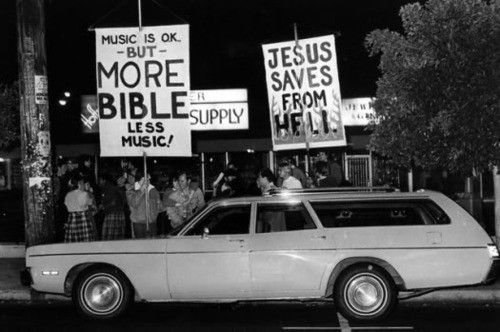
Hardcore Punk Rock Takes Over
A shift from the initial wave of punk rock bands (X, the Go-Go’s, Blondie) to hard core groups (Black Flag, Fear, the Circle Jerks) began in the late 1970s. The Starwood temporarily banned all punk groups after the Weirdos staged a July 4 party in 1977 and torched the American flag. Soon after, a fan of the group Fear stabbed a bouncer, leading to another temporary closure.
“Most clubs that booked punk acts were closed at some point because of complaints from neighbors, revocation of conditional use permits and conflicts between punks and police. Others blacklisted punk acts,” according to “Alternative Rock,” a book by author Dave Thompson.
The Starwood had very little on-site parking, sending concert-goers into the surrounding neighborhood. The club might have been a punk fan’s dream, but it was a nightmare for neighbors. As more hard-core bands were booked, confrontations between the club and its neighbors grew more intense. Soon neighbors complained about fans’ violent acts like bottle throwing, vandalism and attempted rape.
In 1980, The Starwood began shaking down patrons for weapons and refusing admittance to anyone wearing Gestapo-style spikes, heavy gloves and boots. Black Flag’s fans were the most violent, gang-beating anyone inside the Starwood who didn’t look like them.
The L.A. County Sheriff’s Department joined with county Supervisor Ed Edelman and a group called Harassed Neighbors of the Starwood to get the club’s business license revoked. As the legal process proceeded, the Starwood had to shut down for varying periods, depending on the latest court ruling.
The Starwood took its case all the way to California’s Supreme Court before finally losing, and was forced to close in late summer or fall of 1981. The Starwood was demolished in 1983 and a mini-mall, now Crescent Heights Plaza, was built on the site in 1988.

Not necessarily about The Starwood in particular but I wish there were more venues today in different locations as this was at Crescent Heights & Santa Monica. The Odyssey was on Beverly. I love how you can go from one venue to another on Santa Monica in Boystown or the Sunset Strip but it was cool to have more variety throughout the city to mix things up. For that reason I wish The Starwood and The Odyssey were still there.
RE Mike’s comment: Back then, underage kids asked adults to buy booze all the time. Starwood had nothing to do with that, it was everywhere.
I had a friend who once lived just north of the Starwood on Crescent Heights. The building he lived in wasn’t secured so there were times when he came home at night and saw kids doing dope or each other in the hallways. There were countless times when I walked past the club on my way to the bars that some under-aged kid would ask me to buy booze for them at the near-by liquor store. Don’t miss the place at all.